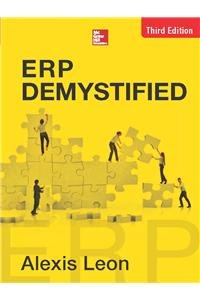Sale!
Erp Demystified (Paperback) | Released: Aug. 2014
By: Leon (Author) Publisher: Tata McGraw-Hill Education22.04% Off ₹725.00
You save ₹205.00
This book demystifies the myths and misconceptions about ERP and provides an overview of the technologies that will work with ERP systems to enable organizations to work at high efficiencies. This updated, revised, and enlarged Third Edition comprehensively covers the implementation of an ERP system that is best suited for... Read More
In stock
Ships within 1-2 Business Days

100% Orginal Books

Easy Replacement

Certified product

Secure Checkout

On time delivery
Author:
![]()
Leon
Publisher Name:
![]()
Tata McGraw-Hill Education
Language:
![]()
English
Binding:
![]()
(Paperback)
About The Book
This book demystifies the myths and misconceptions about ERP and provides an overview of the technologies that will work with ERP systems to enable organizations to work at high efficiencies. This updated, revised, and enlarged Third Edition comprehensively covers the implementation of an ERP system that is best suited for an organization—right from package selection, team selection, implementation plan preparation, implementation, project management and monitoring, training, post implementation tasks, and so on. Covering in detail the various tasks that must be performed after implementing the ERP system, the book also discusses different modules of ERP package and the profile of leading ERP vendors. The future trends in ERP, the emergence of new technologies, and the integration of ERP systems with Internet and World Wide Web is also covered. Additionally, the appendix includes Case Studies to help users better understand how ERP systems are implemented in the real world. About the AuthorAlexis Leon is the managing director of L and L Consultancy Services Private Limited. He has more than 24 years of consulting experience in the areas of software engineering, workflow automation, groupware, product design, process improvement, project management, configuration management, quality assurance, and productivity improvement.Table of Contents: • Preface to the Third Edition
• Preface to the First Edition
Part I INTRODUCTION
1. Enterprise—An Overview
2. Business Processes
3. Introduction to ERP
4. Basic ERP Concepts
5. Justifying ERP Investments
6. Risks of ERP
7. Benefits of ERP
Part II ERP AND TECHNOLOGY
8. ERP and Related Technologies
9. Business Intelligence (BI) and Business Analytics (BA)
10. E-Commerce and E-Business
11. Business Process Reengineering (BPR)
12. Data Warehousing and Data Mining
13. On-line Analytical Processing (OLAP)
14. Product Life Cycle Management (PLM)
15. Supply Chain Management (SCM)
16. Customer Relationship Management (CRM)
17. Geographic Information System (GIS)
18. Advanced Technology and ERP Security
Part III ERP IMPLEMENTATION
19. To be or not to be…
20. Implementation Challenges
21. ERP Implementation (Transition) Strategies
22. ERP Implementation Life Cycle
23. Pre-Implementation Tasks: Getting Ready
24. Requirements Definition
25. Implementation Methodologies
26. ERP Deployment Methods
27. Not All Packages are Created Equal—Package Selection
28. ERP Project Teams
29. Process Definition
30. Vendors and Consultants
31. Employees and Employee Resistance
32. Contracts with Vendors, Consultants, and Employees
33. Training and Education
34. Data Migration
35. Project Management and Monitoring
36. Post-Implementation Activities
37. Success and Failure Factors of an ERP Implementation
Part IV ERP IN ACTION
38. After ERP Implementation …
39. Operation and Maintenance of the ERP System
40. Measuring the Performance of the ERP System
41. Maximizing the ERP System
Part V THE BUSINESS MODULES
42. Business Modules of an ERP Package
43. Financials
44. Manufacturing (Production)
45. Human Resources Management
46. Plant Maintenance
47. Materials Management
48. Quality Management
49. Marketing
50. Sales, Distribution, and Service
Part VI THE ERP MARKET
51. ERP Marketplace and Marketplace Dynamics
52. ERP Vendors
Part VII ERP—PRESENT AND FUTURE
53. Turbo Charge the ERP system
54. Enterprise Application Integration (EAI)
55. ERP and E-Business
56. ERP, Internet, and WWW—ERP II
57. ERP and Total Quality Management
58. Future Directions and Trends in ERP
Part VIII APPENDICES
• Appendix A
• Index









